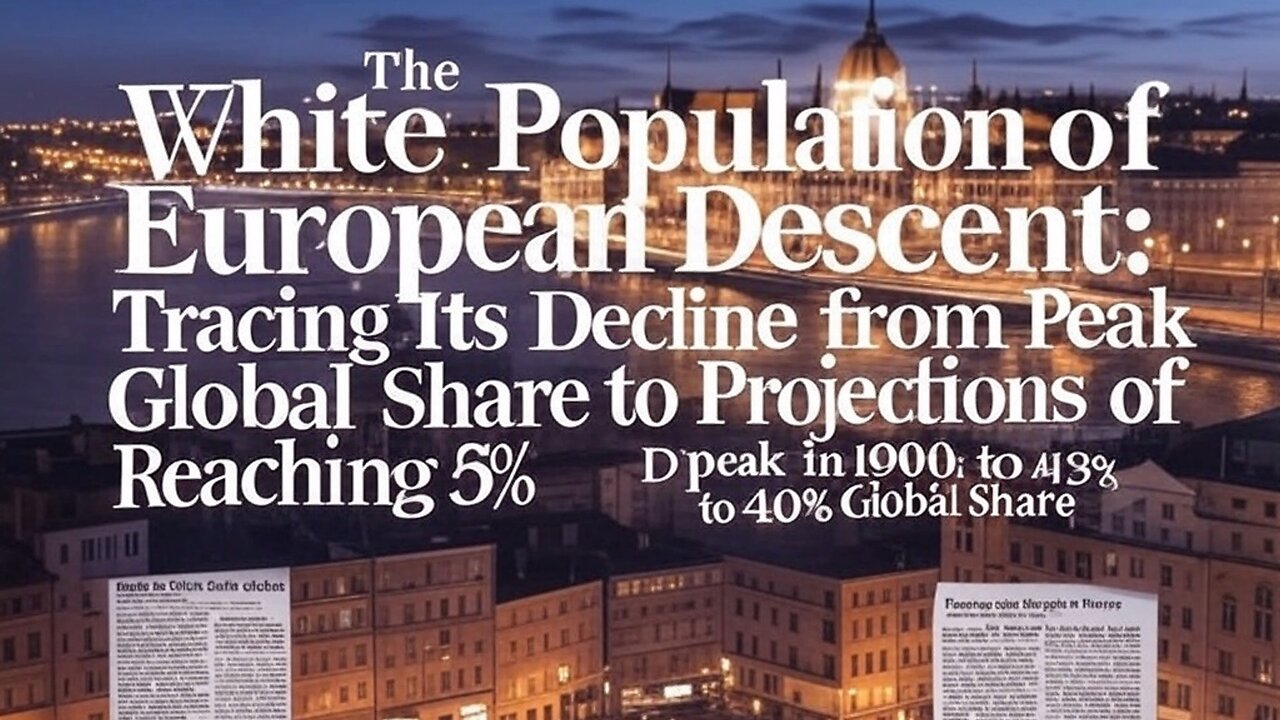Premium Only Content

The White Population of European Descent: Peak Global Share to Projections of Reaching 5%
The proportion of people identified as white and of European descent has changed significantly over time, influenced by global population growth and varying definitions. Around 1900, this group made up an estimated 33% to 40% of the world’s 1.6 billion people, totaling 550 to 600 million. This included 400 million in Europe and others in North America (e.g., 76 million in the U.S.), Canada, Australia, New Zealand, and smaller communities in Africa and Latin America. The range depends on whether only unmixed European ancestry (33%) or partial heritage (up to 40%) is counted.
By March 2025, with a global population of 8.2 billion, this group’s share has dropped to 6% to 16%, or 500 million to 1.3 billion. A middle estimate of 1 billion (12%) includes 740 million in Europe, 200 million in North America (190 million U.S., 25 million Canada), and 25–30 million elsewhere, based on primary European lineage and self-identification per sources like the UN. Broader counts (14%–16%) add 100–200 million with mixed European ancestry, such as in Latin America (e.g., Brazil’s 50 million white-identified), while stricter counts (6%–8%) limit it to 500–650 million, focusing on unmixed lineage, like 450 million in Western Europe.
The decline reflects lower fertility rates (1.5–1.6 children per woman) compared to higher rates elsewhere (e.g., 4.5 in sub-Saharan Africa), a global population rise over five times since 1900, and increased intermarriage (17% of U.S. marriages interracial by 2015), affecting identity and counts.
Projections estimate this group reaching 5% of the world’s population—about 510 million in a 10.2-billion-person world (per UN forecasts peaking in the 2080s)—between 2080 and 2200. Starting from 750 million (9%) in 2025, a rapid 1%–1.5% annual decline could hit 5% by 2080–2100. From 1 billion (12%), a 0.5%–1% drop suggests 2150–2200, with numbers falling to 900 million by 2050 (9% of 9.7 billion) and 800 million by 2100 (8%). Broader estimates (1.3 billion) push this past 2200, while the strictest (500 million) could reach 5% by 2100 if declines exceed 1% yearly.
Future trends depend on fertility, migration, and definitions of "European descent." Lower births or out-migration could speed the decline; immigration might slow it. Identity shifts from intermixing or cultural changes, plus environmental and technological factors, add uncertainty. The drop from 33%–40% in 1900 to 6%–16% in 2025, potentially reaching 5% in 250–300 years, highlights how demographics and classification evolve over time.
Read the unabridged full article at Real Free News
#GlobalPopulation #DemographicTrends #EuropeanAncestry #PopulationProjections #IdentityShift
-
 8:19
8:19
MattMorseTV
10 hours ago $4.41 earnedTrump is ACTUALLY DOING IT.
28.9K33 -
 11:30:43
11:30:43
ZWOGs
12 hours ago🔴LIVE IN 1440p! - Tarkov w/ Casey & crgoodw1n, Kingdom Come Deliverance, & More - Come Hang Out!
26.4K5 -
 2:30:56
2:30:56
We Like Shooting
16 hours ago $1.77 earnedWe Like Shooting 625 (Gun Podcast)
19.9K1 -
 1:45:02
1:45:02
Glenn Greenwald
7 hours agoIsrael Slaughters More Journalists, Hiding War Crimes; Trump's Unconstitutional Flag Burning Ban; Glenn Takes Your Questions | SYSTEM UPDATE #504
125K159 -
 1:29:31
1:29:31
Killerperk
4 hours ago $0.74 earnedRoad to BF6. Come hang out #regiment #bf6
26.2K2 -
 4:35:45
4:35:45
Jokeuhl Gaming and Chat
5 hours agoDARKTIDE - Warhammer 40k w/ Nubes Bloobs and AoA
18.4K1 -
 LIVE
LIVE
Cripiechuccles
6 hours ago😁💚💙MOTA MONDAY WITH CRIPIE💚💙 👌SMOKING, GAMING & WATCHING FLICKS!:😁
43 watching -
 36:11
36:11
Stephen Gardner
4 hours ago🔥'Burn ALL TRUMP FLAGS’ says Tim Walz + Democrat CAUGHT rigging own election!
23.1K14 -
 10:10
10:10
robbijan
1 day agoHollywood’s Hidden Messages: Predictive Programming & What’s Next
17.3K18 -
 40:13
40:13
MattMorseTV
6 hours ago $6.60 earned🔴It's EVEN WORSE than we thought...🔴
31.7K81